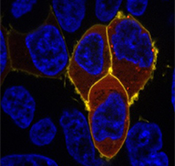Research Updates

A G protein-based designer G protein-coupled receptor illuminates signaling pathways: By designing and using an artificial receptor, an NIDDK-led team has identified a pathway by which a protein in the liver stimulates glucose release. The findings could inform ways to reduce blood glucose levels and may aid in the development of new anti-diabetes drugs. Results published in the Jounal of Biological Chemistry, which named the manuscript Paper of the Week.
BMI and impaired glucose tolerance strongly predict type 2 diabetes in American Indian children: In a prospective cohort study conducted between 1965 and 2007, NIDDK investigators followed children from Arizona’s Gila River Indian Community for development of type 2 diabetes. They found that BMI and impaired glucose tolerance were strong predictors of type 2 diabetes, but other components of the metabolic syndrome were not. Findings were published in the Jounal of Clinical Endocrinology & Metabolism.
Eylea outperforms Avastin for diabetic macular edema with moderate or worse vision loss: A two-year clinical trial supported by NIH’s National Eye Institute and NIDDK compared three drugs for diabetic macular edema and found that gains in vision were greater for participants receiving the drug Eylea than for those receiving Avastin. Gains after two years were about the same for Eylea and Lucentis, but only among people starting treatment with 20/50 or worse vision, contrary to year-one results from the study, which showed Eylea with a clear advantage. The three drugs yielded similar gains in vision for people with 20/32 or 20/40 vision at the start of treatment. Results were published in Ophthalmology.
Genetic mismatches linked to kidney transplant failure: A successful organ transplant depends in part on preventing tissue rejection. How closely tissues match between recipient and donor can influence the transplant’s outcome. In an analysis of kidney transplant data from 1987 to 2013, an NIDDK-led team found that each mismatched pair of tissue proteins increased the risk of failure—indicated by the kidney recipient retuning to dialysis—by 13 percent. Results were published in Transplantation.
Healthy diet may reduce high blood pressure risk after gestational diabetes: Sticking to a healthy diet in the years after pregnancy may reduce the risk of high blood pressure among women who had pregnancy-related (gestational) diabetes, according to a study supported by the NIH’s Eunice Kennedy Shriver National Institute of Child Health and Human Development, the NIH’s National Cancer Institute, and NIDDK. The study was published in Hypertension.
Islet transplantation restores blood sugar awareness and control in type 1 diabetes: New clinical trial results show that transplantation of pancreatic islets—cell clusters that contain insulin-producing cells—prevents severe, potentially life-threatening drops in blood sugar in people with type 1 diabetes. Researchers found that the treatment was effective for people who experienced episodes of severe hypoglycemia—low blood sugar levels that can lead to seizures, loss of consciousness and death—despite receiving expert care. The trial was funded by NIH’s National Institute of Allergy and Infectious Diseases and NIDDK and was conducted by the NIH-sponsored Clinical Islet Transplantation Consortium. Results were published in Diabetes Care.
Transposon reveals new mechanism of genome shuffling in eukaryotes: Transposons are mobile DNA segments that can cause diseases such as cancer when they move to new locations in the genome. However, transposons can also be harnessed as tools for gene therapy. A team including NIDDK investigators has discovered a new mechanism of genome shuffling by transposons. Results were published in Nature Communications.
